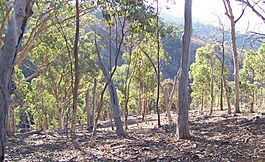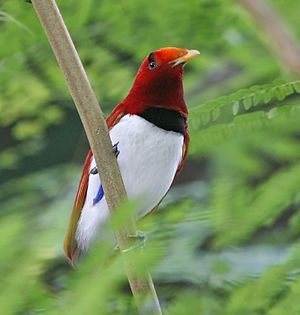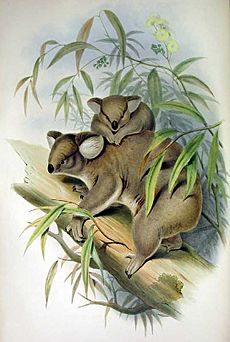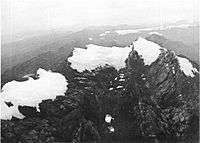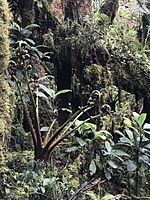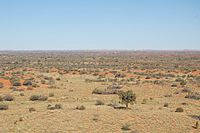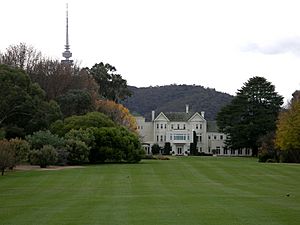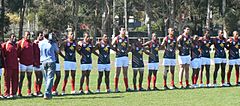Australia (continent) facts for kids
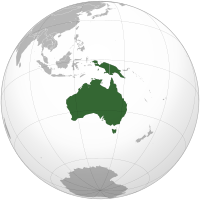 |
|
| Area | 8,600,000 km2 (3,300,000 sq mi) (7th) |
|---|---|
| Population | 38,000,000 (estimated population of Australia, Papua New Guinea, Papua and West Papua for 2019, 6th) |
| Population density | 4.2/km2 (11/sq mi) |
| Demonym | Australian |
| Countries | 3 (Australia, Papua New Guinea and portions of Indonesia) |
| Languages | English, Indonesian, Tok Pisin, Hiri Motu, 269 indigenous Papuan and Austronesian languages, and about 70 Indigenous Australian languages |
| Time zones | GMT+10, GMT+9.30, GMT+8 |
| Internet TLD | .au, .pg and .id |
| Largest cities | List of cities in Australia by population List of cities and towns in Papua New Guinea by population List
Sydney
Melbourne Brisbane Perth Adelaide Gold Coast-Tweed Newcastle-Maitland Canberra-Queanbeyan Sunshine Coast Wollongong Hobart Darwin Port Moresby Lae Jayapura Manokwari |
The continent of Australia is a huge landmass that includes mainland Australia, the island of Tasmania, and the island of New Guinea. New Guinea is split into Papua New Guinea and parts of Indonesia. This continent is sometimes called Sahul, Australinea, or Meganesia to make sure people don't confuse it with just the country of Australia.
Australia is located in a larger area called Oceania. It's the smallest of the seven traditional continents. During the last Ice Age, when sea levels were much lower, these landmasses were all connected by dry land. But over the last 10,000 years, the sea rose, separating them into the dry mainland and the two mountainous islands of New Guinea and Tasmania.
The Australian continent sits on its own tectonic plate. It's known for being the lowest, flattest, and oldest landmass on Earth. New Zealand is not part of the Australian continent. It's on its own separate, mostly underwater continent called Zealandia. Both New Zealand and Australia are part of a region called Australasia.
Papua New Guinea is one of the most diverse countries in the world. It has many different cultures and languages. Most of its people live in rural areas. Australia, the largest part of the continent, has many big cities. It has a strong economy and a high quality of life. The first people arrived in Australia and New Guinea between 50,000 and 30,000 years ago.
Contents
What's in a Name?

The names for this region have changed over time. Before the 1970s, the single landmass during the Ice Age was called Australasia. This name comes from a Latin word meaning "southern."
In the 1970s, the name Greater Australia was used. Later, the name Sahul became popular for the entire continent. In 1984, the name Meganesia was suggested. It means "great island" or "great island-group." This name is often used by scientists. Other names like Australinea and Australia-New Guinea have also been used.
A Look at Its History
Ancient Peoples

Indigenous Australians are the first people who lived on the Australian continent. They are thought to have arrived around 50,000 years ago. Evidence suggests they were among the first humans to migrate out of Africa. The oldest known human remains in Australia were found at Lake Mungo. These remains show signs of one of the world's oldest known cremations. This suggests early religious practices.
The Papuan peoples of New Guinea are believed to have settled there between 42,000 and 48,000 years ago. Trade between New Guinea and nearby Indonesian islands started as early as the 7th century. Ancient empires like Srivijaya and Majapahit had connections with western New Guinea.
Before Europeans Arrived
For a long time, people in Europe believed there was an "unknown land of the South" called Terra Australis Incognita. This idea came from ancient Greek thinkers like Aristotle. He thought there must be a large landmass in the Southern Hemisphere to balance the lands in the north.
Maps from the 15th to 18th centuries often showed this hypothetical continent. Scientists believed it had to exist as a counterweight to the known lands. Over time, as more of the world was explored, the idea of this huge southern continent changed. It eventually included Tierra del Fuego, New Guinea, and what we now call Australia.
European Explorers

In the 17th century, Spanish explorers searched for Terra Australis. The Portuguese navigator Pedro Fernandes de Queirós discovered islands like Pitcairn and Vanuatu. Luís Vaz de Torres sailed through the Torres Strait between Australia and New Guinea. He was the first European to explore this strait.
The first documented European sighting and landing on the Australian continent was by Dutch navigator Willem Janszoon in 1606. He landed on the Cape York Peninsula. Later, Abel Tasman sailed around parts of Australia's coast. He discovered Tasmania (then called Van Diemen's Land) and New Zealand in 1642.
On April 29, 1770, British explorer James Cook and his crew made their first landfall on the mainland of Australia. This was at a place now known as the Kurnell Peninsula. Here, Cook had the first recorded contact with an Aboriginal tribe, the Gweagal. His expedition was the first to explore Australia's eastern coastline.
In 1788, Arthur Phillip led the First Fleet of 11 ships to Sydney. This was to be the site for a new British colony. Phillip described Sydney Cove as the "finest harbour in the world."
Modern Times
In 1883, the Colony of Queensland tried to take control of southern New Guinea. However, the British government didn't approve. In 1884, Britain declared a protectorate over the southern coast of New Guinea. This area became British New Guinea in 1888. In 1902, it was placed under the authority of the newly formed Commonwealth of Australia. In 1906, it officially became the Australian Territory of Papua.
During World War II, Darwin was bombed by Japan in 1942. This was the largest attack by a foreign power on Australia. Japanese forces tried to invade Port Moresby in New Guinea. Between 1942 and 1945, Australian forces fought back against the Japanese in New Guinea.
After 1945, many people from Europe and other parts of the world moved to Australia. This made Australia a very multicultural country. By 2014, Australia's population had grown to over 23 million people.
Papua New Guinea became self-governing in 1973 and gained full independence in 1975. It joined the United Nations shortly after.
How the Land Was Formed
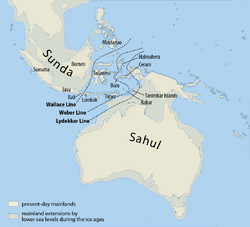
The Australian continent covers about 8.56 million square kilometers. It is the smallest continent where humans live, after Antarctica. The shallow continental shelf connecting the islands is about 2.5 million square kilometers.
Australia is mostly on one large landmass. Because of this, it's sometimes called an "island continent." The continent sits in the middle of a tectonic plate. This means it doesn't have active volcanoes today.
Long ago, Australia was part of a giant supercontinent called Gondwana. About 96 million years ago, the Australian plate began to drift north. For a long time, Australia and New Guinea were one continuous landmass. When the last Ice Age ended around 10,000 BC, rising sea levels separated Tasmania from the mainland. Later, between 8,000 and 6,500 BC, the lowlands in the north flooded. This separated New Guinea, the Aru Islands, and the Australian mainland.
The northern movement of Australia caused the New Guinea Highlands to rise. This collision also created the Torres Strait that now separates Australia and New Guinea. Papua New Guinea has several volcanoes because it's located along the Pacific Ring of Fire. This area often experiences earthquakes and tsunamis. Puncak Jaya in New Guinea is the highest mountain on the continent.
Plants and Animals
Plant Life
For about 40 million years, Australia and New Guinea were almost completely isolated. During this time, the climate became much drier. Many plants developed special ways to survive in dry conditions and after fires. These include hard-leaved plants like Eucalyptus (gum trees) and Acacia (wattle).
The plants in New Guinea are a mix of tropical rainforest species from Asia and plants typical of Australia. As the Australian plate moved north, it eventually collided with the Eurasian plate. This collision created the high mountains of New Guinea. It also formed the Torres Strait. The collision also created islands that acted as "stepping-stones." This allowed plants from Southeast Asia to move to New Guinea, and some Australian plants to move to Southeast Asia.
Animal Life
Because Australia and New Guinea were once connected, they share many types of animals. West Papua has over 300 bird species, with at least 20 found nowhere else. These include the king bird-of-paradise.
Australia has a huge variety of animals. About 83% of its mammals, 89% of reptiles, and 93% of amphibians are found only in Australia. This is because the continent was isolated for so long. Famous Australian animals include the koala, emu, platypus, and kangaroo. The Tasmanian devil is also well-known.
As the continent drifted north, unique animals developed. Marsupials (like kangaroos) and monotremes (like platypuses) are found in other places, but they really thrived in Australia and New Guinea. New Guinea has 284 mammal species, and 195 of them are found only there. It also has a rich variety of coral and fish.
There are three main reasons for the amazing diversity of life here:
- Stable Temperatures: While much of the world cooled, Australia and New Guinea moved towards the equator. This kept temperatures fairly steady, allowing many new species to evolve.
- Isolation: The continent was very isolated. This meant few outside species arrived, allowing unique native forms to develop without much competition.
- Fertile Areas: Even though the continent is old, it has scattered areas of very fertile soil. These areas support a rich variety of life.
Weather and Climate
In New Guinea, the climate is mostly monsoonal with a tropical rainforest climate. Temperatures are usually around 27°C (80°F) all year in lower areas. Higher up, like in Mendi, it's cooler, around 21°C (70°F), with lots of rain and humidity. The New Guinea Highlands are one of the few places near the equator that get snow. Some areas receive a huge amount of rain, about 4500 mm (177 inches) each year.
Most of the Australian landmass has a desert or semi-arid climate. The southern coastal areas have a temperate climate. The east coast has a humid subtropical climate, and the west has a Mediterranean climate. The northern parts of the country have a tropical climate. Snow often falls in the highlands near the east coast, in states like Victoria and New South Wales. Australia can experience very high temperatures, over 50°C (122°F), and also below 0°C (32°F). The El Niño–Southern Oscillation affects Australia's weather, causing both long droughts and very wet periods.
-
Ice cap at top of Puncak Jaya in Papua (1972).
-
A tropical rainforest in Papua New Guinea.
-
Monsoonal squall in Darwin.
-
Snow in Thredbo, a town in the Snowy Mountains.
-
Grassland in Queensland with mountains in background.
People and Cultures
Religions
Christianity is the main religion in the continent. However, many Australians say they don't have a religion. Other religions like Islam, Buddhism, and Hinduism are also practiced in Australia. In New Guinea, traditional religions, often based on animist beliefs, are common. Many Papuans mix their Christian faith with their traditional beliefs.
Languages
The continent has many native languages. These include Australian Aboriginal languages, Papuan languages from New Guinea, and Tasmanian languages. The main languages spoken today are English in Australia, Tok Pisin in Papua New Guinea, and Indonesian in Indonesian New Guinea.
Because of immigration, many other languages are spoken in Australia. These include Italian, Greek, Arabic, Mandarin, and Vietnamese. Papua New Guinea has more languages than any other country. It has over 820 native languages! Most of these languages have fewer than 1,000 speakers.
New Arrivals
Since 1945, over 7 million people have moved to Australia. From the late 1970s, many immigrants came from Asian and other non-European countries. This has made Australia a very multicultural country. Sydney is the most multicultural city in Oceania. More than 250 different languages are spoken there. About 40% of its residents speak a language other than English at home. Melbourne is also very multicultural.
Economy and Money
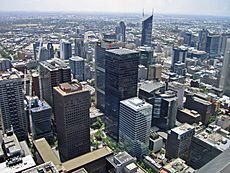
Australia is the only developed country on the Australian-New Guinea continent. Its economy is the largest and most powerful in the region. Australia's economy is one of the biggest in the world. Its wealth per person is higher than that of the UK, Canada, Germany, and France. The Australian Securities Exchange in Sydney is the largest stock exchange in Australia and the South Pacific.
Tourism in Australia is a very important part of Australia's economy. In 2014/15, tourism added A$47.5 billion to the country's economy. In 2015, 7.4 million visitors came to Australia.

Sydney and Melbourne are ranked among the world's most livable cities. Sydney is also a major global city. Melbourne is a leading financial center in the Asia-Pacific region.
Papua New Guinea has many natural resources. These resources make up two-thirds of its export earnings. Papua New Guinea is considered a developing economy. Its mining and resource sector has grown strongly. In 2011, it was one of the fastest-growing economies in the world.
How They Are Governed
Australia is a constitutional monarchy with a parliamentary system. This means Elizabeth II is the Queen of Australia. She is represented in Australia by the Governor-General of Australia. The Governor-General acts on the advice of the government ministers. Australia has two main political groups: the Australian Labor Party (considered centre-left) and the Coalition (considered centre-right). These groups usually form the government.
Papua New Guinea is also a Commonwealth realm. This means Queen Elizabeth II is its head of state. She is represented by the Governor-General of Papua New Guinea. Unlike many other Commonwealth realms, Papua New Guinea's governors-general are chosen by the country's parliament.
Culture and Traditions
Since 1788, Australian culture has been mainly influenced by Western culture, especially from Britain. However, it also has strong Indigenous influences. Over time, a unique Australian culture has developed. American popular culture, especially through TV and movies, has also had a big impact since the mid-20th century. Other cultural influences come from nearby Asian countries and from immigrants from many different nations.
The Australian Museum in Sydney and the National Gallery of Victoria in Melbourne are the oldest and largest museums on the continent. Sydney's New Year's Eve celebrations are the biggest on the continent.
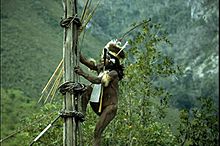
Papua New Guinea is home to more than 7,000 different cultural groups. Most groups have their own language. This amazing diversity means there are many different styles of art, performance, and architecture. Papua New Guinea is famous for its carved wooden sculptures, masks, and canoes.
Australia has a very old tradition of Aboriginal art, going back thousands of years. The most famous forms are rock art and bark painting. You can find ancient Aboriginal rock art throughout the continent. Important sites include Uluru and Kakadu National Park. Aboriginal culture includes practices and ceremonies based on the belief in the Dreamtime. Respect for the land and oral traditions are very important.
Sports
Popular sports in Papua New Guinea include various types of football (like rugby league, rugby union, and Australian rules football), cricket, and volleyball. Rugby league is the most popular sport in Papua New Guinea and is unofficially its national sport.
In Australia, cricket is the most popular sport overall. For women, netball is very popular. Australian rules football has the most spectators and TV viewers. Australia has hosted the Summer Olympics twice: in Melbourne in 1956 and Sydney in 2000. It has also hosted the Commonwealth Games five times.
Images for kids
-
Baliem Valley in the New Guinea Highlands
-
The Sydney Opera House is an iconic image of Sydney, and the continent itself. Ranking highly in quality of life measurements, Sydney is consistently selected as one of the world's most liveable cities.
-
Spring in the apple orchards of Tasmania.}}
See also
 In Spanish: Sahul para niños
In Spanish: Sahul para niños



